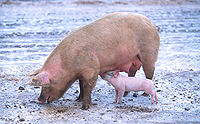- Razorback
-
Razorback 
A pair of razorbacks on Merritt Island, Florida Scientific classification Kingdom: Animalia Phylum: Chordata Class: Mammalia Order: Artiodactyla Family: Suidae Genus: Sus Species: S. scrofa Binomial name Sus scrofa
Linnaeus, 1758Razorback is an Americanism, loosely applied to any type of feral pig or wild boar in North America. The term has also appeared in Australia, to describe said animals in that country.
Contents
Introduction to the Americas
Domestic pigs were first introduced to the Americas in the 16th century.[1]
Christopher Columbus is known to have intentionally released domestic swine in the West Indies during his second voyage in order to provide future expeditions with a freely available food supply.[citation needed]
Hernando de Soto is known to have introduced Eurasian domestic swine to Florida in 1539, although Juan Ponce de León may have introduced the first pigs into mainland Florida in 1525.
The practice of introducing domestic pigs into the New World continued throughout the exploration periods of the sixteenth and seventeenth centuries.[1] It is thought that the Eurasian wild boar (Sus scrofa scrofa), which originally ranged from Great Britain to European Russia may have also been introduced.[2]
In South America, during the early 20th century, free-ranging boars[clarification needed] were introduced in Uruguay for hunting purposes and eventually crossed the border into Brazil in the 1990s, quickly becoming an invasive species. Licensed private hunting of both feral boars and their hybrids with domestic pigs was authorized from August 2005 on in the Southern Brazilian state of Rio Grande do Sul,[3] although their presence as a pest had been already noticed by the press as early as 1994.[4] Releases and escapes from unlicensed farms (established because of increased demand for boar meat as an alternative to pork), however, continued to bolster feral populations and by mid-2008 licensed hunts had to be expanded to the states of Santa Catarina and São Paulo.[5]
Recently-established Brazilian boar populations are not to be confused with long established populations of feral domestic pigs (porcos monteiros), which have existed mainly in the Pantanal for more than a hundred years, along with native peccaries. The demographic dynamics of the interaction between feral pigs populations and those of the two native species of peccaries (Collared Peccary and White-lipped Peccary) is obscure and is being studied presently. It has been proposed that the existence of feral pigs could somewhat ease jaguar predation on peccary populations, as jaguars would show a preference for hunting pigs, when these are available.[6]
As of 2008, the estimated population of 4 million feral hogs cause an estimated US$800 million of property damage a year in the U.S.[7]
Appearances in popular culture
The most widely-recognized appearance of the razorback or wild boar in American popular culture is as the sports mascot for the University of Arkansas in Fayetteville. The Arkansas Razorbacks play in the Southeastern Conference, a Division I (NCAA) American intercollegiate athletic association. The mascot's name is Tusk. The Arkansas Razorbacks' logo is a razorback hog, seen in silhouette, usually red on white or white on red. Moreover, the University of Arkansas' unique sports cheer is known as "Calling the Hogs." The chant is usually written as "Woo Pig Sooie," ostensibly the call used by domestic hog farmers to bring their stock to the trough for feeding (thus arguably recognizing that the original "hogs" were, in fact, domestic swine, despite the razorback living in the wild as a feral animal today).
See also
References
- ^ a b History of Wild Swine in the United States
- ^ (Italian)Scheggi, Massimo (1999). La Bestia Nera: Caccia al Cinghiale fra Mito, Storia e Attualità. pp. 201. ISBN 8825379048.
- ^ "INSTRUÇÃO NORMATIVA Nº 71, DE 04 DE AGOSTO DE 2005". SERVIÇO PÚBLICO FEDERAL MINISTÉRIO DO MEIO AMBIENTE INSTITUTO BRASILEIRO DO MEIO AMBIENTE E DOS RECURSOS NATURAIS RENOVÁVEIS. 2009-02-13. http://www.institutohorus.org.br/download/marcos_legais/INSTRUCAO_NORMATIVA_N_71_04_agosto_2005.pdf.
- ^ "Javali: fronteiras rompidas" ("Boars break across the border") Globo Rural 9:99, January 1994, ISSN 0102-6178, pgs.32/35
- ^ Cecconi, Eduardo (2009-02-13). "A técnica da caça do javali: Reprodução desordenada do animal é combatida com o abate". Terra de Mauá. http://www.arroiogrande.com/especiais_javali.htm.
- ^ Furtado, Fred (2009-02-13). "Invasor ou vizinho? Invasor ou vizinho? Estudo traz nova visão sobre interação entre porco-monteiro e seus ’primos’ do Pantanal". Ciencia Hoje. http://www.cienciahoje.uol.com.br/controlPanel/materia/view/3835.
- ^ Brick, Michael (2008-06-21). "Bacon a Hard Way: Hog-Tying 400 Pounds of Fury". The New York Times. http://www.nytimes.com/2008/06/21/sports/othersports/21hogs.html?hp.
Pigs Domestic SelectionHusbandryPig farming • Intensive pig farming • Sty • Pannage • Pig toilet • Hog oiler • Gestation crate • Cross-fostering • Swine diseases • SwineherdAs food or
other productPig slaughter • Pig scalder • Suckling pig • Pork • Ham • Bacon • Lard • Blood • Dishes • Pig bladderOther uses
Wild
FeralPigs in culture Iron Age pig • Miss Piggy • Porky Pig • "The Three Little Pigs" • Babe • Charlotte's Web • The Sheep-PigGame animals and shooting in North America Game birds Bobwhite Quail · Chukar · Hungarian Partridge · Prairie Chicken · Mourning Dove · Ring-necked pheasant · Ptarmigan · Ruffed Grouse · Sharp-tailed Grouse · Snipe (Common Snipe) · Spruce Grouse · Turkey · WoodcockWaterfowl Black Duck · Canada Goose · Canvasback · Gadwall · Greater Scaup · Lesser Scaup · Mallard · Northern Pintail · Redhead · Ross's Goose · Snow Goose · Wood DuckBig game Bighorn Sheep · Black Bear · Razorback · Brown Bear · Bison (Buffalo) · Caribou · Cougar (Mountain Lion) · Elk · Moose · White-tailed deer · Gray wolf · Mountain goat · Mule Deer · Pronghorn · Muskox · Dall Sheep · Polar BearOther quarry American alligator · Bobcat · Coyote · Fox Squirrel · Gray Fox · Gray Squirrel · Opossum · Rabbit · Raccoon · Red Fox · Snowshoe HareSee also Categories:- Pig breeds
- Fauna of the Southeastern United States
- Invasive animal species
- Mammals of the United States
- American English
Wikimedia Foundation. 2010.

